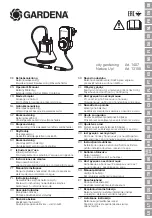
Instructions
Thank you for purchasing the DP-415 hybrid DMX pack. This product has been thoroughly tested
at our factory for quality and assurance. Your comments regarding our products and services are
always welcome. You can reach us by sending an e-mail to [email protected]. It is both a
privilege and pleasure serving you. Please be sure to read these instructions before operating this
unit and keep them in a safe place for possible reference later.
The DP-415 is a 4 channel portable dimmer/switch pack. Each output channel contains dual 15 Amp Edison
sockets that allow for two devices to be plugged into a single channel. Each channel can then be controlled via
standard DMX 512 signal by adjusting a relevant channel fader on your DMX console. The dip switches on the face
of the unit allow you to set the DMX patch address and operation mode for the pack. Standard binary code should
be used to set your DMX patch address. Dip Switch 10 is the “Mode” switch. The setting of this switch determines
the packs’ operation mode, either as a Dimmer or Switch pack. There are also 4 channel output LED’s that allow you
to view active channels. When the unit is set to Dim mode, these LED’s dim in real time as the relevant channel is
adjusted. A DMX signal indicator LED is also incorporated so that when DMX signal is present, the LED illuminates.
Product Description:
No. 24-004-1516 Rev 1.1
Page 1
Warning:
This unit must be earthed.
Keep the unit dry, do not expose it to water or high levels of humidity.
Do not allow for any flammable liquids to come in close contact with the unit.
Technical repairs should be performed by an authorized technician.
Do not operate this unit if the internal components are exposed.
When replacing fuses, always replace with the same type and value.
Introduction:
The DP-415 was designed to be mounted on any form of pipe using an approved rigging clamp or onto any flat
surface via hardware that is not included with the product.
To fasten a clamp to the unit, we recommend that you use either of the
two supplied center holes. One is on the top side and the other is on the rear. Use the one that better suites your
rig. Another means of hanging the unit, is by turning the rear panel around 180º. You will need a phillips head
screw driver to reverse the panel. Disconnect the
power cord, remove the four phillips head screws on the
back of the unit, reverse the panel so the flanged side is facing out and replace the four phillips head screws.
This will allow you to hang the pack onto any 2” pipe
The final means of mounting this unit is onto a flat surface
where you can secure at least two bolts. This means an exposed wood beam, metal beam, wall that you can
determine has enough support to hold the units weight, etc... There are three holes on the back panel supplied for
this form of mounting. Use at least two of them, (preferably, the two outside holes) with at least 2” lag bolts.
Note: there should always be at least 12” of
clearance between the pack and anything surrounding it. It is also recommended that you use a safety
cable whenever mounting over head.
units'
(If you use this method to hang the unit, you must use a
safety cable to ensure the unit does not fall down).
Mounting:
The DP-415 is supplied with a 15 Amp, 12 gauge power line cord. Plug the line cord into a service capable of
suppling up to 15 amps to the pack. Lamp loads should be plugged into the dual 15 Amp Edison sockets which are
fitted on the sides of the pack and are clearly marked on the front panel.
. Be sure to not overload any channel as this may result in blown fuses and malfunction. Using a
3 pin XLR, DMX cable, connect out of your DMX console or previous fixture in line and into the DMX IN of the
DP-415. Connect out of the DP-415, DMX OUT, and into the input of the next device in line. Set Dip Switches as
required (See Page 3- “Set DMX Address”). It is recommended that the last pack or fixture in line include a DMX
terminator into the Output. This will minimize data transmission errors.
Each channel can accept a load of up to 5
Amps or 600 Watts
Connections:






















